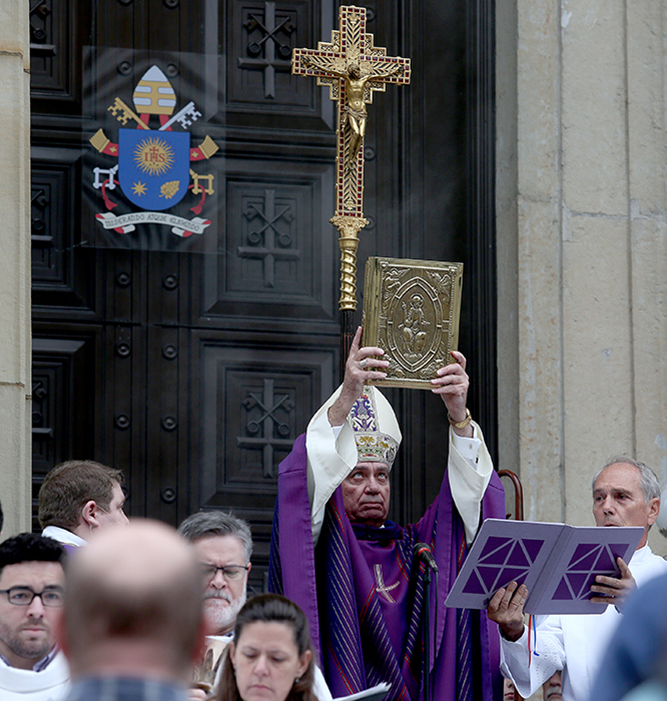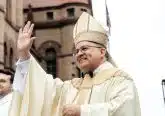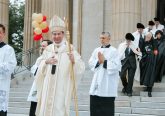Archbishop Schnurr opens Holy Door, urges faithful to accept the challenge of mercy

On Sunday, Dec. 13 Archbishop Dennis M. Schnurr opened the Holy Door at the Cathedral of St. Peter in Chains, beginning the Extraordinary Jubilee Year of Mercy in the Archdiocese of Cincinnati.
More then 400 people were present for the 11 a.m. Sunday Mass which began with “Rite of the Opening of the Door of Mercy in Local Churches.” The assembly began in the undercroft of the cathedral as Archbishop Schnurr introduced the rite. After a reading from the Gospel of Luke (the Lost Sheep) and a reading from Pope Francis’ Bull of Indiction Misericordiae Vultus, the archbishop led the assembly to the front door of the cathedral, which had been sealed shut since Nov. 1.
Upon arrival at the door, Archbishop Schnurr said, “Open the gates of justice, we shall enter and give thanks to the Lord.” The doors were then opened and the archbishop said, “This is the Lord’s gate: let us enter through it and obtain mercy and forgiveness.” The assembly then entered the church through the Holy Door.
At the end of the Mass Archbishop Schnurr gave the Apostolic Blessing with a plenary indulgence.
The Holy Door will remain symbolically open until Nov. 20, 2016 when the Year of Mercy ends on the Solemnity of Christ the King. The Extraordinary Jubilee Year of Mercy officially began Dec. 8 when Pope Francis opened the Holy Door at the St. Peter’s Basilica in Rome.
In his homily Dec. 13, Archbishop Schnurr said Pope Francis is challenging every Christian to be “merciful like the Father,” the theme of the jubilee year.
“I encourage you to accept that challenge,” the archbishop said. “In a particular way, Pope Francis is calling Catholics to missionary discipleship through the theological virtue of mercy. And, in the context of an age that is often not only unaccepting of but actively hostile to our faith, I invite you to think of witnessing to the faith – both in word and deed; before family, friends, and strangers. To witnessing to the faith as a spiritual work of mercy that includes counseling the doubtful, instructing the ignorant, and admonishing sinners. ”
Throughout his homily Archbishop Schnurr gave concrete examples of how Catholics can witness to mercy. Specifically he said it is merciful to reach out in love to baptized Catholics who have fallen away, to invite our fellow Catholics to become intentional disciples and to speak truth in love during this present age of relativism.
“In the context of a culture that is often unaccepting of and even hostile to our faith, it would be so much easier to offer “maintenance discipleship” rather than “missionary discipleship” – to continue to take the stance that speaking the truth in love is really not my responsibility, that publicly witnessing to the faith is not my responsibility, that faith formation of others is not my responsibility,” he said. “It would be so much easier to remain silent on the cultural realities that are fundamentally opposed to the teachings of Christ. It would indeed be easier, but it would not be merciful to do so.”
The Extraordinary Jubilee Year of Mercy also includes the opportunity for anyone Catholic to obtain a plenary indulgence. Pope Francis laid out the necessary steps to the indulgence in a letter to Archbishop Rino Fisichella, President of the Pontifical Council for the Promotion of the New Evangelization in September.
“To experience and obtain the Indulgence, the faithful are called to make a brief pilgrimage to the Holy Door, open in every Cathedral or in the churches designated by the Diocesan Bishop, and in the four Papal Basilicas in Rome, as a sign of the deep desire for true conversion,” the Holy Father wrote. “Likewise, I dispose that the Indulgence may be obtained in the Shrines in which the Door of Mercy is open and in the churches which traditionally are identified as Jubilee Churches.”
For his full letter, CLICK HERE.
According to the Vatican’s website, “to gain indulgences, whether plenary or partial, it is necessary that the faithful be in the state of grace at least at the time the indulgenced work is completed,” and, “a plenary indulgence can be gained only once a day.”
The site goes on, “In order to obtain it, the faithful must, in addition to being in the state of grace:
— have the interior disposition of complete detachment from sin, even venial sin;
— have sacramentally confessed their sins;
— receive the Holy Eucharist (it is certainly better to receive it while participating in Holy Mass, but for the indulgence only Holy Communion is required);
— pray for the intentions of the Supreme Pontiff.
For the full list of general conditions related to indulgences, CLICK HERE.
While symbolically open for the duration of the jubilee year, pilgrims to the Cathedral of St. Peter in Chains should note the church does lock up after hours. Monday through Friday the church is open from 7 a.m. to 6 p.m. Saturday from 10 a.m. to 6 p.m. and on Sundays during the regularly scheduled Mass times of 8:30 a.m., 11 a.m., and 6 p.m.
In addition to the Holy Door at the Cathedral, holy doors were opened Sunday at several designated pilgrimage sites within the archdiocese. For a list of the pilgrimage sites, CLICK HERE. For hours at the pilgrimage sites, please call the church listed at the preceding link.













